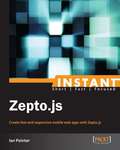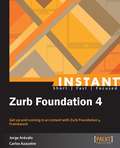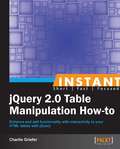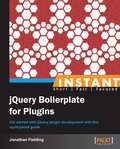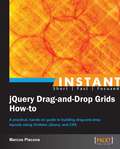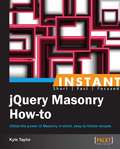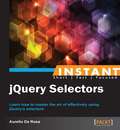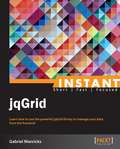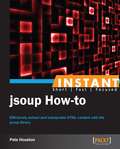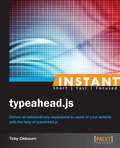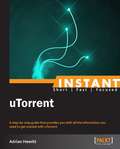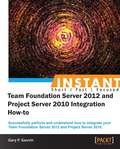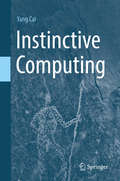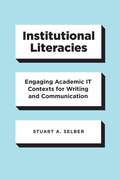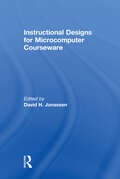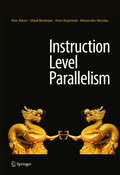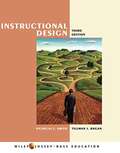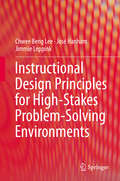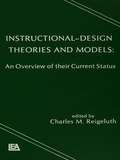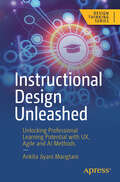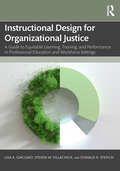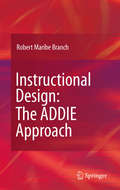- Table View
- List View
Instant Zepto.js
by Ian PointerA simple starter guide that will walk you through Zepto.js from installation to more advanced topics using a step-by-step approach with useful examples included along the way.Instant Zepto.js is designed for web developers with some jQuery experience who are interested in speeding up and enhancing their web applications, especially on mobile devices.
Instant Zurb Foundation 4
by Jorge Arevalo Carlos AzaustreA quick and easy guide that follows a practical approach to rapidly create responsive web pages using Foundation 4 framework, following the mobile-first philosophy.If you are a web developer who wants to get the most out of your HTML5/CSS/JavaScript skills, this book is ideal for you. It is assumed that you will have some experience with these languages, but for those who don't, you can also be up and running in an instant.
Instant jQuery 2.0 Table Manipulation How-to
by Charlie GrieferFilled with practical, step-by-step instructions and clear explanations for the most important and useful tasks. Get the job done and learn as you go. A how-To book with practical recipes accompanied with rich screenshots for easy comprehension.A short, concise, recipe-based approach that shows you how to manipulate tables using hands-on examples and the most up-to-date techniques in jQuery 2.0.Instant jQuery 2.0 Table Manipulation How-to is aimed at both newcomers and those who have already worked with JavaScript or jQuery. A familiarity with HTML and basic CSS would be beneficial.
Instant jQuery Boilerplate for Plugins
by Jonathan FieldingFilled with practical, step-by-step instructions and clear explanations for the most important and useful tasks. This book is a how-to manual complete with recipes that range from writing a simple plug-in to adding enhancements/features to your plug-in.This book is for JavaScript enthusiasts who are looking for hands on recipes to help them develop their own plug-ins.
Instant jQuery Drag-and-Drop Grids How-to
by Marcos PlaconaFilled with practical, step-by-step instructions and clear explanations for the most important and useful tasks.A Packt How-to guide which contains a set of step-by-step instructions to help you build highly functional drag-and-drop layouts."Instant jQuery Drag-and-Drop Grids How-to" has been written for any web developer looking to improve their layouts and add dynamic behaviour to their site.
Instant jQuery Masonry How-to
by Kyle TaylorFilled with practical, step-by-step instructions and clear explanations for the most important and useful tasks. Get the job done and learn as you go. A concise guide that delivers immediate results with practical recipes on customizing your projects.If you have a basic understanding of jQuery, HTML, and CSS3, this book is for you. We will go over what Masonry is, how it works, and the best practices on how to implement it in your projects.
Instant jQuery Selectors
by Aurelio De RosaFilled with practical, step-by-step instructions and clear explanations for the most important and useful tasks. Instant jQuery Selectors follows a simple how-to format with recipes aimed at making you well versed with the wide range of selectors that jQuery has to offer through a myriad of examples.Instant jQuery Selectors is for web developers who want to delve into jQuery from its very starting point: selectors. Even if you're already familiar with the framework and its selectors, you could find several tips and tricks that you aren't aware of, especially about performance and how jQuery acts behind the scenes.
Instant jQuery UI Starter
by Jesse BoyerGet to grips with a new technology, understand what it is and what it can do for you, and then get to work with the most important features and tasks.A quick and easy-to-follow book on jQuery UI, it's is packed with the features of jQuery UI that you need to know to enhance your web applications.This book is aimed at people who have heard about jQuery UI but don't feel like they've had a thorough introduction.
Instant jqGrid
by Gabriel ManricksGet to grips with a new technology, understand what it is and what it can do for you, and then get to work with the most important features and tasks. A step-by-step, practical Starter book, Instant jqGrid embraces you while you take your first steps, and introduces you to the content in an easy-to-follow order.This book is aimed at people who have some knowledge of HTML and JavaScript. Knowledge of PHP and SQL would also prove to be beneficial. No prior knowledge of jqGrid is expected.
Instant jsoup How-to
by Pete HoustonFilled with practical, step-by-step instructions and clear explanations for the most important and useful tasks. This book will take a how-to approach, focusing on recipes that demonstrate Jsoup.If you are working in data scraping, data crawling, or within a similar area using Java, then this book is the one for you. This book acts as a fast-paced and simple guide to enhance your HTML data manipulating skills using one of the most well-known libraries, Jsoup.
Instant typeahead.js
by Toby OsbournFilled with practical, step-by-step instructions and clear explanations for the most important and useful tasks. Instant Typeahead.js is a concise guide with 14 recipes which deals with everything you need to know to become proficient in using this tool and teaches you how to integrate it with other popular projects such as WordPress, Bootstrap, and Ruby on Rails.Instant Typeahead.js is for any web developer who would like to learn more about Typeahead.js in terms of what it can offer and the best ways to achieve common tasks. This book assumes no prior knowledge, but an understanding of JavaScript fundamentals would be useful.
Instant uTorrent
by Adrian HewittGet to grips with a new technology, understand what it is and what it can do for you, and then get to work with the most important features and tasks.This book takes a practical, hands-on approach to installing and using uTorrent.This book is great for tech-savvy users who are familiar with network basics and who are looking for an easy-to-follow guide to the BitTorrent technology using uTorrent as the program of choice.
InstantTeam Foundation Server 2012 and Project Server 2010 Integration How-to
by Gary P. GauvinFilled with practical, step-by-step instructions and clear explanations for the most important and useful tasks. Get the job done and learn as you go. A how-To book with practical recipes accompanied with rich screenshots for easy comprehension.The How-to style is a very practical book which will take the reader through the process of garnering a basic understanding of TFS and Project Server with practical tutorials and recipes.This book is for users who want to integrate TFS 2012 and Project Server 2010. Readers are expected to know some basic Windows Server commands and account management, and have administrative access to the servers being configured.
Instinct Combat Shooting: Defensive Handgunning for Police, Fourth Edition
by Chuck KleinWhile much has been written about instinct shooting with long guns, very little had been published on doing so with a handgun until this publication. Written by a pioneering author of the concept, Instinct Combat Shooting: Defensive Handgunning for Police, now in its fourth edition, is not about winning target shooting competitions, but purports surviving real-life firefights by examining testimonies of shootout survivors and carefully analyzing firefights that prove shooting instinctively is not only crucially fast, but also equally accurate. The book defines instinctive combat shooting as: "The act of operating a handgun by focusing on the target, as opposed to the sights, and instinctively coordinating the hand and mind to cause the handgun to discharge at a time and point that ensures interception of the projectile with the target." The concepts behind instinct combat shooting discussed in this book are now being integrated into some of the most progressive police academies in the United States and around the world. New chapters provide valuable material dispelling myths on indexing, laser sights, and other trick-shooting methods. Intended to help officers survive close-quarter combat conditions, Instinct Combat Shooting is an essential tool for police looking to improve their close-range shooting skills and enhance their firefight survival.
Instinctive Computing
by Yang CaiThis book attempts to connect artificial intelligence to primitive intelligence. It explores the idea that a genuinely intelligent computer will be able to interact naturally with humans. To form this bridge, computers need the ability to recognize, understand and even have instincts similar to humans. The author organizes the book into three parts. He starts by describing primitive problem-solving, discussing topics like default mode, learning, tool-making, pheromones and foraging. Part two then explores behavioral models of instinctive cognition by looking at the perception of motion and event patterns, appearance and gesture, behavioral dynamics, figurative thinking, and creativity. The book concludes by exploring instinctive computing in modern cybernetics, including models of self-awareness, stealth, visual privacy, navigation, autonomy, and survivability. Instinctive Computing reflects upon systematic thinking for designing cyber-physical systems and it would be a stimulating reading for those who are interested in artificial intelligence, cybernetics, ethology, human-computer interaction, data science, computer science, security and privacy, social media, or autonomous robots.
Institutional Literacies: Engaging Academic IT Contexts for Writing and Communication
by Stuart A. SelberInformation technologies have become an integral part of writing and communication courses, shaping the ways students and teachers think about and do their work. But, too often, teachers and other educational stakeholders take a passive or simply reactive role in institutional approaches to technologies, and this means they are missing out on the chance to make positive changes in their departments and on campus. Institutional Literacies argues that writing and communication teachers and program directors should collaborate more closely and engage more deeply with IT staff as technology projects are planned, implemented, and expanded. Teachers need to both analyze how their institutions approach information technologies and intervene in productive ways as active university citizens with relevant expertise. To help them do so, the book offers a three-part heuristic, reflecting the reality that academic IT units are complex and multilayered, with historical, spatial, and textual dimensions. It discusses six ways teachers can intervene in the academic IT work of their own institutions: maintaining awareness, using systems and services, mediating for audiences, participating as user advocates, working as designers, and partnering as researchers. With these strategies in hand, educators can be proactive in helping institutional IT approaches align with the professional values and practices of writing and communication programs.
Instruction Design for Microcomputing Software
by David H. JonassenSelected as one of the outstanding instructional development books in 1989 by the Association for Educational Communications and Technology, this volume presents research in instructional design theory as it applies to microcomputer courseware. It includes recommendations -- made by a distinguished group of instructional designers -- for creating courseware to suit the interactive nature of today's technology. Principles of instructional design are offered as a solid base from which to develop more effective programs for this new method of teaching -- and learning.
Instruction Level Parallelism
by Alex Aiken Utpal Banerjee Arun Kejariwal Alexandru NicolauThis book precisely formulates and simplifies the presentation of Instruction Level Parallelism (ILP) compilation techniques. It uniquely offers consistent and uniform descriptions of the code transformations involved. Due to the ubiquitous nature of ILP in virtually every processor built today, from general purpose CPUs to application-specific and embedded processors, this book is useful to the student, the practitioner and also the researcher of advanced compilation techniques. With an emphasis on fine-grain instruction level parallelism, this book will also prove interesting to researchers and students of parallelism at large, in as much as the techniques described yield insights that go beyond superscalar and VLIW (Very Long Instruction Word) machines compilation and are more widely applicable to optimizing compilers in general. ILP techniques have found wide and crucial application in Design Automation, where they have been used extensively in the optimization of performance as well as area and power minimization of computer designs.
Instructional Design
by Patricia L. Smith Tillman J. RaganA well-documented, theory-based treatment that focuses on instructional design’s application to industry and K-12 education. Offers extensive procedural assistance, emphasizing the foundations and first principles upon which most of the models and procedures in the field are built. An Extended Example (now online) showcases applications of concepts and techniques using a single subject area and course (Digital Photography).
Instructional Design Principles for High-Stakes Problem-Solving Environments
by Chwee Beng Lee José Hanham Jimmie LeppinkThis book examines the types of problems and constraints faced by specialists in the areas of security, medicine, mental health, aviation and engineering. Every day we rely on highly trained specialists to solve complex problems in high-stakes environments, that is, environments involving direct threats to the preservation of human life. While previous work has tended to focus on problem solving in a single domain, this book covers multiple, related domains. It is divided into three parts, the first of which addresses the theoretical foundations, with coverage of theories of instructional design and expertise. Part two covers the five high-stakes domains and offers directions for training in these domains. In turn, part three provides practical guidelines for instructional design in high-stakes professions, including learner analysis, task analysis, assessment and evaluation. The book is intended for a broad readership, including those who operate in high-stress, time-pressure occupations. Trainers at professional organisations can utilise the theoretical frameworks and training strategies discussed in this book when preparing their clients for complex, real-world problem solving. Further, the book offers a valuable resource for academics and graduate students, as well as anyone with an interest in problem solving.
Instructional Design Theories and Models: An Overview of Their Current Status
by Charles M. ReigeluthInstructional Design Theories and Models is a thorough yet concise overview of eight of the most comprehensive and best-known attempts to integrate knowledge about effective and appealing instruction. Chapters were written by the original theorists to provide a more accurate and behind-the-scenes look at the theories' development. Instructional Des
Instructional Design Unleashed: Unlocking Professional Learning Potential with UX, Agile and AI Methods (Design Thinking)
by Ankita Jiyani MangtaniDive into the expansive realm of instructional design and explore a rich tapestry of effective strategies and practical techniques. This comprehensive guide is a treasure trove of insights bridging the theoretical foundations of instructional design with hands-on, actionable methods to elevate learning experiences. After reviewing the fundamentals, you’ll unravel the essence of instructional design, what it entails, and how its principles can be harnessed. Your journey then delves into the scientific underpinnings of learning in professional settings, dissecting pivotal concepts such as cognitive load, cognitive load theory (CLT), learning styles, and modalities. The guide extends its reach to address inclusivity, promoting equitable practices, and mitigating unconscious bias during the design of learning courses and environments. With a solid foundation in place, you’ll examine key frameworks specific to learning and instructional design, including the tried-and-true methodologies of ADDIE, SAM, and ARCS. Going beyond the conventional, the guide widens its lens to incorporate broader methodologies, such as user-experience (UX), Agile methodologies, storyboarding, and gamification, all prevalent in the tech industry. It also delves into virtual learning environments and the nuances of creating effective online learning experiences and contemplates the revolutionary impact of generative AI on reshaping this space. With a forward-looking perspective, Instructional Design Unleashed anticipates and navigates the potential changes and innovations that AI can introduce, positioning instructional designers at the forefront of the evolving landscape of educational technology. What You’ll Learn Uncover the scientific foundations of learning and their seamless integration into the learning experience. Explore practical methodologies and techniques that can be readily applied to enhance your learning projects. Study the vast potential of generative AI within the realms of e-learning and virtual learning environments. Unlock the innovative possibilities for the future of educational technology. Who This Book Is For Instructional designers, eLearning developers, educators, trainers, app developers, UX designers, and anyone involved in creating effective learning experiences.
Instructional Design for Organizational Justice: A Guide to Equitable Learning, Training, and Performance in Professional Education and Workforce Settings
by Lisa A. Giacumo Steven W. Villachica Donald A. StepichInstructional Design for Organizational Justice prepares instructional designers to use culturally relevant, performance-based learning materials and environments that improve organizational and workplace learning experiences for today’s diverse, globalized contexts. With socially just leadership and DEI initiatives growing in institutions across sectors, today’s instructional design programs must prepare graduate students to be more culturally relevant, equity-minded, and inclusive in their professional practice. This textbook explores the implementation of systematic, systemic, and performance-oriented designs alongside the use of organizational justice theory to facilitate more equitable, inclusive performance improvement and workplace learning interventions.The book introduces the Learning and Performance Support Instructional Design (LeaPs ID) Model. Applicable to instructional designers, educational technologists, learning experience designers, learning engineers, and human resource development professionals, this original, iterative process: integrates common ID heuristics, design-based thinking, culture, equity, inclusion, and other inputs external to the organization and ID project; portrays a realistic, scalable, iterative, agile approach to the ID process; aids in the design of environments in which adult learners can observe, practice, and receive feedback, building the knowledge and capacity required for their desired performance; and is illustrated by a wealth of examples, templates, and processes developed in the field to support adult learners and collaborate with subject matter experts. Relevant to business, government, military, non-profit, non-governmental, and higher education settings, this unique and comprehensive volume lends itself to uncovering values and motives essential to successful agile project management as well as to diversity, equity, and inclusion initiatives and social change.
Instructional Design with Emerging Technologies: Theory, Practice, and Research
by Heng LuoBridging the gap between instructional design (ID) theory and practice in today's technology-enhanced learning environments, the book extends the current understanding of instructional science with an up-to-date perspective on emerging technologies and their affordances for teaching and learning.Positioning ID as a systematic process informed by theoretical assumptions, empirical evidence, and pragmatic considerations, this book provides an in-depth description and reflective analysis of good practice in technology-enhanced learning and design with a tripartite framework of pedagogy, technology, and evidence. It covers well-established ID theories and models with real-life examples of their effective integration with technological innovations. The book aims to advance the understanding of ID from both pedagogical and technological perspectives to improve educational practice and theory development in the information age.The book will be of interest to students and academics in educational technology, instructional science, and instructional design, as well as instructional designers and teachers.
Instructional Design: The ADDIE Approach
by Robert Maribe BranchThe Analyze, Design, Develop, Implement, and Evaluate (ADDIE) process is used to introduce an approach to instruction design that has a proven record of success. Instructional Design: The ADDIE Approach is intended to serve as an overview of the ADDIE concept. The primary rationale for this book is to respond to the need for an instruction design primer that addresses the current proliferation of complex educational development models, particularly non-traditional approaches to learning, multimedia development and online learning environments. Many entry level instructional designers and students enrolled in related academic programs indicate they are better prepared to accomplish the challenging work of creating effective training and education materials after they have a thorough understanding of the ADDIE principles. However, a survey of instructional development applications indicate that the overwhelming majority of instructional design models are based on ADDIE, often do not present the ADDIE origins as part of their content, and are poorly applied by people unfamiliar with the ADDIE paradigm. The purpose of this book is to focus on fundamental ADDIE principles, written with a minimum of professional jargon. This is not an attempt to debate scholars or other educational professionals on the finer points of instructional design, however, the book's content is based on sound doctrine and supported by valid empirical research. The only bias toward the topic is that generic terms will be used as often as possible in order to make it easy for the reader to apply the concepts in the book to other specific situations.
